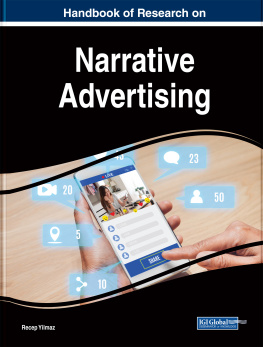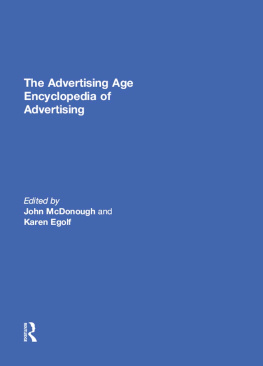
Native Advertising
Native Advertising examines the emerging practices and norms around native advertising in US and European news organizations. Over the past five years native advertising has rapidly become a significant revenue stream for both digital news upstarts and legacy newspapers and magazines.
This book helps scholars and students of journalism and advertising to understand the news industrys investment in native advertising, and consider the effects this investment might have on how news is produced, consumed, and understood. It is argued that although they have deep roots in earlier forms of advertising, native ads with a political or advocacy bent have the potential to shift the relationship between news outlets and audiences in new ways, particularly in an era when trust in the media has reached a historic low point. Beyond this, such advertisements have the potential to shift how media systems function in relation to state power, by changing the relationship between commercial and non-commercial speech.
Drawing on real-world examples of native ads and including an in-depth case study contributed by Ava Sirrah, Native Advertising provides an important assessment of the potential consequences of native advertising becoming an even more prominent fixture in the 21st-century news feed.
Lisa Lynch is Associate Professor and Director of the Program in Media and Communications, Drew University, USA.
Ava Sirrah is a doctoral candidate in Communications at Columbia University, USA. Previously, she worked on brand partnerships in T Brand Studio at The New York Times .
Disruptions: Studies in Digital Journalism
Series editor: Bob Franklin
Disruptions refers to the radical changes provoked by the affordances of digital technologies that occur at a pace and on a scale that disrupts settled understandings and traditional ways of creating value, interacting and communicating both socially and professionally. The consequences for digital journalism involve far reaching changes to business models, professional practices, roles, ethics, products and even challenges to the accepted definitions and understandings of journalism. For Digital Journalism Studies, the field of academic inquiry which explores and examines digital journalism, disruption results in paradigmatic and tectonic shifts in scholarly concerns. It prompts reconsideration of research methods, theoretical analyses and responses (oppositional and consensual) to such changes, which have been described as being akin to a moment of mind blowing uncertainty.
Routledges new book series, Disruptions: Studies in Digital Journalism , seeks to capture, examine and analyse these moments of exciting and explosive professional and scholarly innovation which characterize developments in the day-to-day practice of journalism in an age of digital media, and which are articulated in the newly emerging academic discipline of Digital Journalism Studies.
Mobile Disruptions in the Middle East
Lessons from Qatar and the Arabian Gulf Region in mobile media content innovation
John V. Pavlik, Everette E. Dennis, Rachel Davis Mersey and Justin Gengler
Native Advertising
Advertorial Disruption in the 21st-Century News Feed
Lisa Lynch
For more information about this series, please visit: www.routledge.com/Disruptions/book-series/DISRUPTDIGJOUR
First published 2018
by Routledge
2 Park Square, Milton Park, Abingdon, Oxon OX14 4RN
and by Routledge
711 Third Avenue, New York, NY 10017
Routledge is an imprint of the Taylor & Francis Group, an informa business
2018 Lisa Lynch
Going native at The New York Times: a case study Ava Sirrah
The right of Lisa Lynch and Ava Sirrah to be identified as authors of this work has been asserted by them in accordance with sections 77 and 78 of the Copyright, Designs and Patents Act 1988.
All rights reserved. No part of this book may be reprinted or reproduced or utilised in any form or by any electronic, mechanical, or other means, now known or hereafter invented, including photocopying and recording, or in any information storage or retrieval system, without permission in writing from the publishers.
Trademark notice: Product or corporate names may be trademarks or registered trademarks, and are used only for identification and explanation without intent to infringe.
British Library Cataloguing-in-Publication Data
A catalogue record for this book is available from the British Library
Library of Congress Cataloging-in-Publication Data
A catalog record has been requested for this book
ISBN: 978-1-138-04041-0 (hbk)
ISBN: 978-1-315-17511-9 (ebk)
Typeset in Times New Roman
by Apex CoVantage, LLC
To Zohar and Uma, who know what the fox says.
1
Native advertising saves the newsroom?
A series in The Atlantic about the revival of Newark, New Jersey. Short web documentaries and long-form articles in The Guardian featuring stories from refugee camps around the world. A round-up piece on emerging threats, including cyber war, chemical and biological weapons, and drones, on the Washington Post website. A gripping multimedia package about fighting an Ebola outbreak in Sierra Leone in Politico . A collection of short pieces on Chinese business and civic life in The Wall Street Journal .
These five articles four from legacy media publications and one from a well-established digital news site ( Politico ) are well-written, meticulously reported, and timely, and their subject matter is characteristic of public service journalism or international reporting. In terms of tone, prose style, and content, they mesh seamlessly with the other reporting to be found in their respective publications: still, they are different. Each is set apart from ordinary editorial content by distinguishing fonts, layouts, or labeling: for example, the Atlantic piece uses a distinctive sans-serif font and has a banner across the top describing their series as a Re:Think original, while the Guardian series is distinguished by the logo of Guardian Labs. These labels identify these articles as native advertisements, content created by news organizations that is meant to appear almost, but not exactly, like the news you are reading. No matter how audiences consume news these days, ads like these are everywhere, and it is more likely than not that you have come across a number of them and not realized they were ads at all.
Native advertising is a growth industry, with global returns expected to reach close to 20 billion by 2018 (BI Intelligence 2015; Beer 2017).compete with, their own editorial product. But though the consensus (for the moment, at least) is that over the next few years native advertising will become a more prominent fixture in the 21st century news feed, the consequences of this shift have only begun to be assessed by media scholars.
Building on the work of these scholars as well as my own research into the history, growth, output, and future plans of media content studios this book is an overview of the emerging practices and norms around native advertising, with a particular focus on advertisements which attempt to sway the readers feelings about social or political issues. My argument here is that, though they have deep roots in earlier forms of advertising, native ads with a political or advocacy bent have the potential to shift the relationship between news outlets and audiences in new ways, particularly in an era when trust in the media has reached a historic low point. Beyond this, such advertisements have the potential to shift how media systems function in relation to state power, by changing the relationship between commercial and non-commercial speech.









